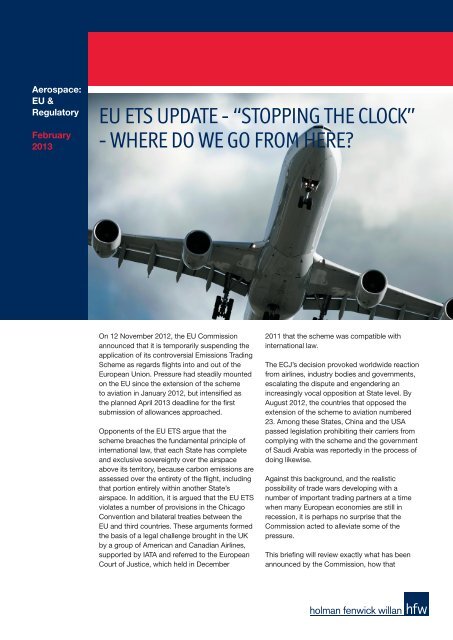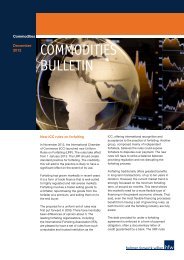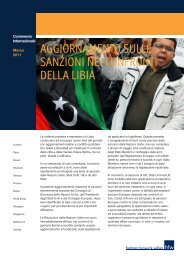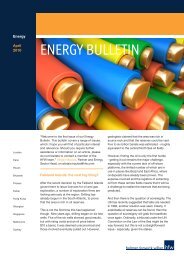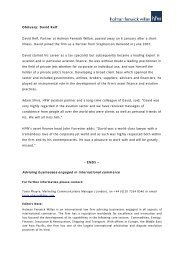Download file as PDF - HFW
Download file as PDF - HFW
Download file as PDF - HFW
You also want an ePaper? Increase the reach of your titles
YUMPU automatically turns print PDFs into web optimized ePapers that Google loves.
Aerospace:EU &RegulatoryFebruary2013EU ETS UPDATE - “STOPPING THE CLOCK”- WHERE DO WE GO FROM HERE?On 12 November 2012, the EU Commissionannounced that it is temporarily suspending theapplication of its controversial Emissions TradingScheme <strong>as</strong> regards flights into and out of theEuropean Union. Pressure had steadily mountedon the EU since the extension of the schemeto aviation in January 2012, but intensified <strong>as</strong>the planned April 2013 deadline for the firstsubmission of allowances approached.Opponents of the EU ETS argue that thescheme breaches the fundamental principle ofinternational law, that each State h<strong>as</strong> completeand exclusive sovereignty over the airspaceabove its territory, because carbon emissions are<strong>as</strong>sessed over the entirety of the flight, includingthat portion entirely within another State’sairspace. In addition, it is argued that the EU ETSviolates a number of provisions in the ChicagoConvention and bilateral treaties between theEU and third countries. These arguments formedthe b<strong>as</strong>is of a legal challenge brought in the UKby a group of American and Canadian Airlines,supported by IATA and referred to the EuropeanCourt of Justice, which held in December2011 that the scheme w<strong>as</strong> compatible withinternational law.The ECJ’s decision provoked worldwide reactionfrom airlines, industry bodies and governments,escalating the dispute and engendering anincre<strong>as</strong>ingly vocal opposition at State level. ByAugust 2012, the countries that opposed theextension of the scheme to aviation numbered23. Among these States, China and the USAp<strong>as</strong>sed legislation prohibiting their carriers fromcomplying with the scheme and the governmentof Saudi Arabia w<strong>as</strong> reportedly in the process ofdoing likewise.Against this background, and the realisticpossibility of trade wars developing with anumber of important trading partners at a timewhen many European economies are still inrecession, it is perhaps no surprise that theCommission acted to alleviate some of thepressure.This briefing will review exactly what h<strong>as</strong> beenannounced by the Commission, how that
announcement h<strong>as</strong> been greetedby the international community and,perhaps most importantly, whatcarriers should be doing now and inthe months ahead.“Stopping the clock”The Commission announced on 12November that it is recommending theEU “stops the clock” when it comesto the enforcement of the inclusion ofaviation in the EU ETS for flights to andfrom non-European countries. A draftdecision w<strong>as</strong> subsequently publishedand can be summarised <strong>as</strong> follows:• No enforcement action will betaken against aircraft operatorswhich do not meet the Directive’sreporting and complianceobligations before 1 January2014, in respect of flights to orfrom aerodromes outside of theEU (including the EEA States,Switzerland and Croatia).• This is conditional on theaircraft operator returning to itsAdministering Member State anyfree allowances it h<strong>as</strong> received in2012 that have been granted forsuch flights.• The Directive’s reporting andcompliance obligations continueto apply in full to flights betweenaerodromes in the EU.The Commission h<strong>as</strong> stressed thatthis is a temporary me<strong>as</strong>ure, designedto give space for and build on recentprogress made by the InternationalCivil Aviation Organization (ICAO). Theexplanatory notes accompanying thedraft decision reinforce the messagethat obligations have been suspended,rather than waived, and that progressmust be made at or before the ICAOAssembly in September 2013.In effect, the EU h<strong>as</strong> bought itselfsome time and may have re-directedsome of the pressure towards ICAOin the process.Practical impact - issues toconsiderIt is important to note that theCommission’s decision is a proposalat this stage and requires approvalby the European Council andParliament before it becomes legallybinding. That should not be an issuein practice but it may take severalmonths for the process to complete.However, the EU institutions mustact to ensure that the decision h<strong>as</strong>legislative effect in advance of April2013 to avoid uncertainty at nationallevel.The practical application of thedecision raises numerous potentialissues and, without detailedguidance from the EU, one canonly speculate <strong>as</strong> to how these willbe addressed. Perhaps the mostfundamental issue is the potentialimpact on EU carriers and, inparticular, low cost carriers thatoperate very large numbers of dailyservices, in some circumstancesentirely between EU airports. All ofthese services will be subject to theDirective’s reporting and complianceobligations. Arguably the effect ofthis will be to distort competition,something that the ECJ’s AdvocateGeneral expressly contemplatedin her Opinion rejecting the legalchallenge: “If the EU legislaturehad excluded airlines holding thenationality of a third country fromthe EU emissions trading scheme,those airlines would have obtainedan unjustified competitive advantageover their European competitors.”She also recognised that excludingflights to or from an aerodrome in athird country from the EU ETS riskedunequal treatment, contrary to theobjective of the Directive.It is entirely possible that a furtherlegal challenge will follow given thepotential impact on competitionbetween the airlines, particularly incircumstances where this potentialimpact h<strong>as</strong> already been expresslyrecognised by the Advocate General.A separate issue concernsthe temporary nature of theCommission’s decision and whathappens when the clock startsticking again on 1 January 2014.The Commission h<strong>as</strong> stated thatif ICAO fails to deliver before thisdeadline, the EU ETS will be applied“automatically”. But what will happenif me<strong>as</strong>ures are agreed at the ICAOAssembly in September 2013 butimplementing such me<strong>as</strong>ures takesseveral years, <strong>as</strong> will surely bethe c<strong>as</strong>e? Presumably, now thatthe Commission h<strong>as</strong> accepted inprinciple that the scheme can besuspended, further suspensions arelikely pending the implementationof me<strong>as</strong>ures agreed at the ICAOAssembly, however long thatprocess may take. If that proves tobe the c<strong>as</strong>e then European carriers(particularly low cost carriers) willcontinue to suffer.International reaction to theCommission’s DecisionReaction to the Commission’sDecision from airlines and industrybodies h<strong>as</strong> been mixed. IATAconsider it represents “a significantstep in the right direction” whilst theAssociation of Asia Pacific Airlinescautiously welcomed the news02 Aerospace: EU & Regulatory
<strong>as</strong> did the International Air CargoAssociation. In stark contr<strong>as</strong>t, theEuropean Regions Airline Associationh<strong>as</strong> warned that the Commissionis effectively introducing a two-tiersystem that unfairly penalises manyEuropean carriers.The response from the USA h<strong>as</strong>been to p<strong>as</strong>s into law its anti-ETSbill, which h<strong>as</strong> now been signed byPresident Obama, following approvalby the House of Representatives(on the day after the Commissionannounced the suspension). Thelegislation empowers the Secretaryof Transportation to prohibitoperators of US aircraft fromparticipating in the ETS if doing sowould not be “in the public interest”.The message from the US remainsone of unequivocal non-acceptanceof the scheme, and the temporarysuspension h<strong>as</strong> not changedanything in that regard.What should carriers do now?Against this uncertain backgroundand pending further guidance fromthe Commission, the best advice forcarriers is to continue monitoring,verifying and reporting emissions inexactly the same way <strong>as</strong> they havebeen doing. This will ensure thatcarriers are not prejudiced in theevent that the suspension of the ETSis lifted in January 2014.In order to benefit from theCommission’s Decision, carrierswill have to return an amount ofallowances corresponding to anyfree emissions allowances issued tothem in 2012 in respect of all non-EU flights. Thus, carriers wishing totake advantage of the suspensionwill have to take positive action byreturning these free allowances inorder to avoid potential enforcementaction. Recent guidance issuedby the Commission confirms thatcarriers must purch<strong>as</strong>e replacement2012 aviation allowances if theyhave already sold any of the freeallowances that they are requiredto surrender in order to benefit fromthe derogation. Further guidance onhow this process will work and whenthe allowances should be returned isstill awaited but carriers should notdispose of or sell any free allowancesin the meantime.A separate issue concerns theapplication of ETS surcharges ontickets. Some airlines have beenimposing a levy on tickets fortravel to and from EU airports <strong>as</strong> ameans of combating the additionalcost of purch<strong>as</strong>ing allowancesand complying with the scheme.This issue is already attractingsome attention, with environmentalgroups levelling accusations ofwindfall profits against carriers whohave imposed the surcharges. Inprinciple, an ETS surcharge can stillbe imposed to reflect the continuedcost of complying with the scheme,even in circumstances whereallowances are not being purch<strong>as</strong>ed,but airlines should exercise cautionand make sure the surchargeremains re<strong>as</strong>onable and justified. TheCommission have implied that ETSsurcharges should either be used toinvest in carbon emissions reductionor returned to p<strong>as</strong>sengers.Focus on ICAO - what does thefuture hold?There is no doubt that the spotlightof this dispute will now shift ontoICAO, who will come under pressureto devise and agree me<strong>as</strong>ures thatwill satisfy the EU. That will not bean e<strong>as</strong>y t<strong>as</strong>k - ICAO encomp<strong>as</strong>ses191 Member States and reaching aconsensus will be a challenging andtime consuming process, particularlywhere such a divisive issue isconcerned. Indeed, ICAO’s SecretaryGeneral h<strong>as</strong> already cautioned thatfurther delays beyond the September2013 Assembly meeting cannot beruled out.That said, progress is clearly beingmade at ICAO <strong>as</strong> the Commissionh<strong>as</strong> recognised. ICAO h<strong>as</strong> set upa high-level working group that isconsidering three possible globalmarket-b<strong>as</strong>ed me<strong>as</strong>ures, rangingfrom a straightforward carbonoffsetting scheme to a global ETS.It is hoped that one of these threeme<strong>as</strong>ures will be selected by March2013 and a detailed framework (atthe very le<strong>as</strong>t) will have been draftedfor consideration at the September2013 meeting. Expecting anythingbeyond this is perhaps unrealistic.Whether or not the EU EmissionsTrading Scheme can survive in thelong term remains to be seen butthat must be doubtful in light of theserecent developments.It will be obvious from this articlethat the regulation of aviationcarbon emissions remains anextremely contentious subject. TheCommission’s decision h<strong>as</strong> beenwelcomed by many airlines butstrongly criticised by others, whowill surely continue to question whatthey perceive to be an unequal andanti-competitive proposal. ICAOmust seize the opportunity affordedto devise me<strong>as</strong>ures that are focusedon the important objective ofreducing global emissions but are fairand consistent in their application.Failing that, this internationalAerospace: EU & Regulatory 03
dispute will resume with incre<strong>as</strong>edfervour in January 2014 when theCommission’s deadline expires andthe clock ticks again.For more information, ple<strong>as</strong>e contactSue Barham, Partner, on +44 (0)207264 8309 or sue.barham@hfw.com,or Richard Gimblett, Partner, on+44 (0)20 7264 8016 orrichard.gimblett@hfw.com, orKonstantinos Adamantopoulos,Partner, on +32 2 643 3401 orkonstantinos.adamantopoulos@hfw.com,or Charles Cockrell, Associate, on+971 4 423 0555 or charles.cockrell@hfw.com, or your usual <strong>HFW</strong> contact.For more information,ple<strong>as</strong>e also contact:Sue BarhamLondon PartnerT: +44 (0)20 7264 8309sue.barham@hfw.comPierre FrühlingParis PartnerT: +33 (0)1 44 94 40 50pierre.fruhling@hfw.comKonstantinos AdamantopoulosBrussels PartnerT: +32 2 535 7861konstantinos.adamantopoulos@hfw.comRichard GimblettDubai PartnerT: +971 4 423 0555richard.gimblett@hfw.comMert HifziSingapore PartnerT: +65 6305 9503mert.hifzi@hfw.comPeter ColesHong Kong PartnerT: +852 3983 7711peter.coles@hfw.comJeremy ShebsonSão Paulo PartnerT: +55 (11) 3179 2903jeremy.shebson@hfw.comLawyers for international commerce hfw.comHOLMAN FENWICK WILLAN LLPFriary Court, 65 Crutched FriarsLondon EC3N 2AEUnited KingdomT: +44 (0)20 7264 8000F: +44 (0)20 7264 8888© 2013 Holman Fenwick Willan LLP. All rights reservedWhilst every care h<strong>as</strong> been taken to ensure the accuracy of this information at the time of publication, the information is intended <strong>as</strong> guidance only. It should not beconsidered <strong>as</strong> legal advice.Holman Fenwick Willan LLP is the Data Controller for any data that it holds about you. To correct your personal details or change your mailing preferences ple<strong>as</strong>econtact Craig Martin on +44 (0)20 7264 8109 or email craig.martin@hfw.com


